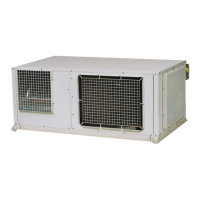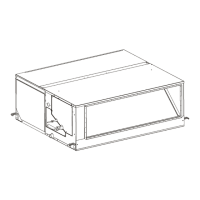Do you have a question about the Hitachi RPI-2.0FSN4E and is the answer not in the manual?
Copyright and disclaimer information regarding publication reproduction and printing errors.
Overview of the product range, including model identification and classification.
Pre-installation checks to verify model name, system type, and included documentation.
Details on how FSXN1E outdoor units can be combined to achieve different capacities.
Essential safety precautions and warnings to prevent injury and damage during installation and operation.
Further safety guidelines, including handling electric shock, service covers, and fire precautions.
Information on pressure vessel compliance and safety device handling, emphasizing potential hazards.
Specifies the operating temperature limits for cooling and heating modes for the system.
Details on the operation of remote control units for system management.
Description of built-in automatic functions like three-minute protection, frost prevention, and defrost cycles.
Identification and listing of parts for the RAS-8FSXN1E outdoor unit model.
Identification and listing of parts for the RAS-(10/12)FSXN1E outdoor unit models.
Identification and listing of parts for the RAS-(14/16)FSXN1E outdoor unit models.
Identification and listing of parts for the RAS-(5/6)FSXNH(E) outdoor unit models.
Identification and listing of parts for the RAS-(8-12)FSXNH(E) outdoor unit models.
Diagram illustrating the refrigerant flow for RAS-(8-12)FSXN1E models.
Diagram illustrating the refrigerant flow for RAS-(14/16)FSXN1E models.
Diagram illustrating the refrigerant flow for RAS-(5/6)FSXNH(E) models.
Diagram illustrating the refrigerant flow for RAS-(8-12)FSXNH(E) models.
Guidelines for secure and damage-free transport of outdoor units using appropriate methods.
Instructions on the correct method for lifting units using slings, emphasizing safety.
Information on the center of gravity for various outdoor unit models to ensure stable lifting.
Criteria for selecting the installation location for the outdoor unit, considering environmental factors and access.
Specifications for the required clearance around the outdoor unit for installation and maintenance.
Detailed installation guidelines based on surrounding wall configurations.
Instructions for creating a stable foundation and securing the outdoor unit.
Guidelines for selecting the correct diameter and type of refrigerant pipes for system compatibility.
General guidelines for installing refrigerant pipes, including flared connections and insulation practices.
Specific instructions for connecting refrigerant pipes for heat pump and heat recovery systems.
Key precautions for installing outdoor units, including unit order and pipe placement.
Procedure for performing an air-tight test to ensure the refrigerant system is leak-free.
Method for calculating the amount of additional refrigerant needed based on piping length and system configuration.
Strict safety observations required for installers and designers regarding refrigerant leaks.
Guidelines for installing drainage pipes for condensation, including location and kit usage.
General safety precautions and guidelines before starting electrical wiring work.
Wiring diagrams and procedures for connecting power supply circuits to outdoor and indoor units.
Specifications for minimum wire sizes for power source and transmission cables.
Instructions for connecting electrical wiring to the outdoor unit's terminal board.
Location and procedure for setting DIP switches on the PCB1 for unit configuration.
Instructions for setting external inputs/outputs and various unit functions via the control panel.
Essential checks to perform before starting the test run to ensure proper system setup and safety.
Step-by-step procedure for performing the test run on the system.
Instructions for using the PC-ARF remote control to perform the test run.
A checklist to verify the correct operation and parameters during the test run.
A list of common alarm codes, their categories, content, and possible causes for troubleshooting.
Details on the devices and combinations used to protect the compressor from operational hazards.
Troubleshooting steps for when the system fails to operate, checking temperature settings and airflow.
Troubleshooting steps for common operational issues related to refrigeration or heating modes.
Action to take if problems persist after basic troubleshooting, including contacting service.
Copyright and disclaimer information regarding publication reproduction and printing errors.
Overview of the product range, including model identification and classification.
Pre-installation checks to verify model name, system type, and included documentation.
Details on how FSXN1E outdoor units can be combined to achieve different capacities.
Essential safety precautions and warnings to prevent injury and damage during installation and operation.
Further safety guidelines, including handling electric shock, service covers, and fire precautions.
Information on pressure vessel compliance and safety device handling, emphasizing potential hazards.
Specifies the operating temperature limits for cooling and heating modes for the system.
Details on the operation of remote control units for system management.
Description of built-in automatic functions like three-minute protection, frost prevention, and defrost cycles.
Identification and listing of parts for the RAS-8FSXN1E outdoor unit model.
Identification and listing of parts for the RAS-(10/12)FSXN1E outdoor unit models.
Identification and listing of parts for the RAS-(14/16)FSXN1E outdoor unit models.
Identification and listing of parts for the RAS-(5/6)FSXNH(E) outdoor unit models.
Identification and listing of parts for the RAS-(8-12)FSXNH(E) outdoor unit models.
Diagram illustrating the refrigerant flow for RAS-(8-12)FSXN1E models.
Diagram illustrating the refrigerant flow for RAS-(14/16)FSXN1E models.
Diagram illustrating the refrigerant flow for RAS-(5/6)FSXNH(E) models.
Diagram illustrating the refrigerant flow for RAS-(8-12)FSXNH(E) models.
Guidelines for secure and damage-free transport of outdoor units using appropriate methods.
Instructions on the correct method for lifting units using slings, emphasizing safety.
Information on the center of gravity for various outdoor unit models to ensure stable lifting.
Criteria for selecting the installation location for the outdoor unit, considering environmental factors and access.
Specifications for the required clearance around the outdoor unit for installation and maintenance.
Detailed installation guidelines based on surrounding wall configurations.
Instructions for creating a stable foundation and securing the outdoor unit.
Guidelines for selecting the correct diameter and type of refrigerant pipes for system compatibility.
General guidelines for installing refrigerant pipes, including flared connections and insulation practices.
Specific instructions for connecting refrigerant pipes for heat pump and heat recovery systems.
Key precautions for installing outdoor units, including unit order and pipe placement.
Procedure for performing an air-tight test to ensure the refrigerant system is leak-free.
Method for calculating the amount of additional refrigerant needed based on piping length and system configuration.
Strict safety observations required for installers and designers regarding refrigerant leaks.
Guidelines for installing drainage pipes for condensation, including location and kit usage.
General safety precautions and guidelines before starting electrical wiring work.
Wiring diagrams and procedures for connecting power supply circuits to outdoor and indoor units.
Specifications for minimum wire sizes for power source and transmission cables.
Instructions for connecting electrical wiring to the outdoor unit's terminal board.
Location and procedure for setting DIP switches on the PCB1 for unit configuration.
Instructions for setting external inputs/outputs and various unit functions via the control panel.
Essential checks to perform before starting the test run to ensure proper system setup and safety.
Step-by-step procedure for performing the test run on the system.
Instructions for using the PC-ARF remote control to perform the test run.
A checklist to verify the correct operation and parameters during the test run.
A list of common alarm codes, their categories, content, and possible causes for troubleshooting.
Details on the devices and combinations used to protect the compressor from operational hazards.
Troubleshooting steps for when the system fails to operate, checking temperature settings and airflow.
Troubleshooting steps for common operational issues related to refrigeration or heating modes.
Action to take if problems persist after basic troubleshooting, including contacting service.
| Brand | Hitachi |
|---|---|
| Model | RPI-2.0FSN4E |
| Category | Air Conditioner |
| Language | English |












